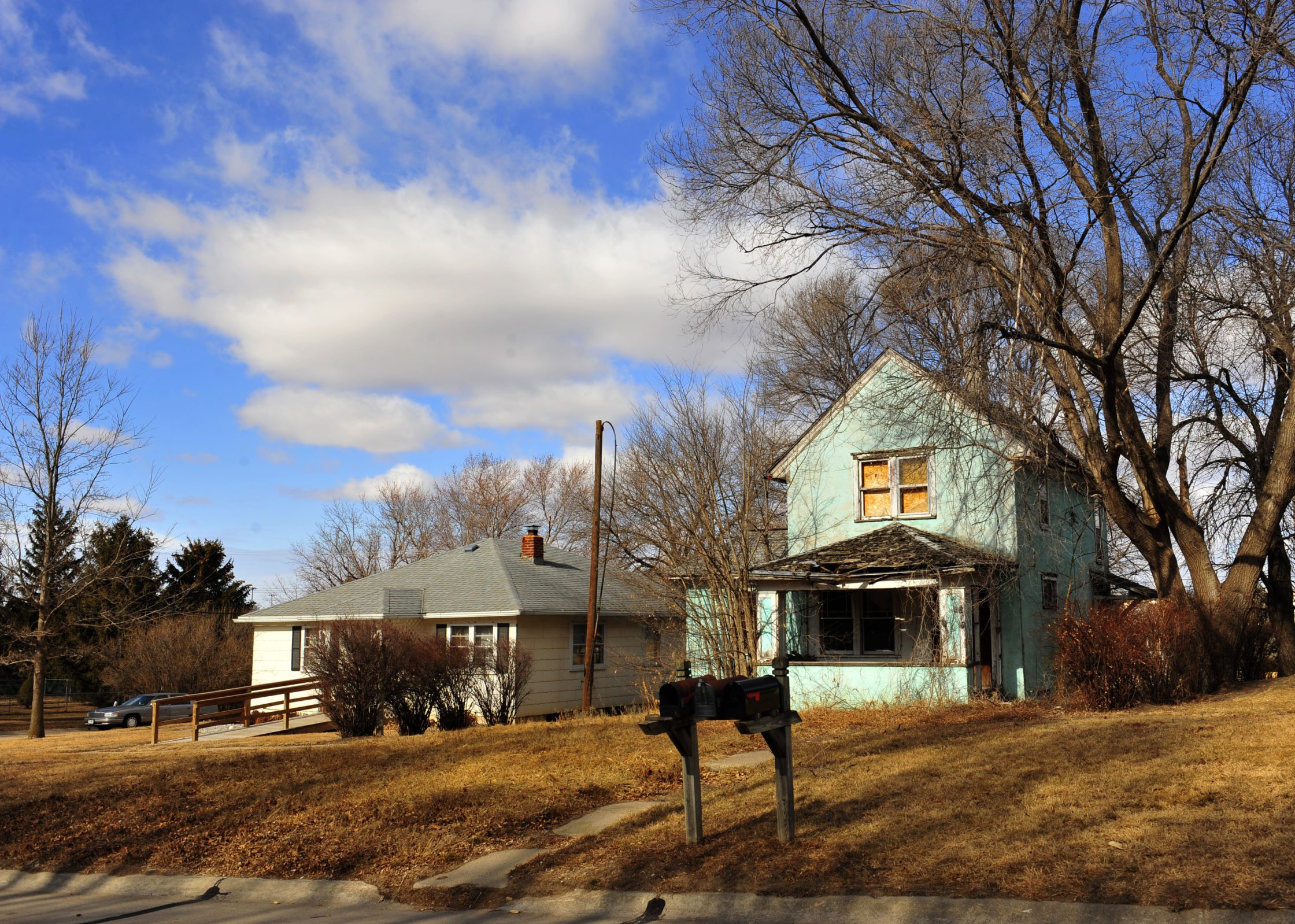The process has become frustratingly familiar to Vince Dugan.
Three times in the past two months, he’s offered someone a job at Trego-Dugan, a national aviation company headquartered in North Platte for more than 50 years.
All three times, the potential aircraft maintenance manager or national safety director has accepted the high-skilled job, ready to move to North Platte with a family and boost the city’s population of 23,390.
But then comes the biggest challenge — finding a home. All three times, Dugan’s potential hires backed out after looking at the North Platte housing market and failing to find a suitable home.
“Even with competitive wages, we’re unable to get people to move here,” Dugan said. “Not because they are afraid of coming to rural America, but because they have nowhere to live.”
It’s a struggle familiar to nearly every Nebraska mid-sized city and small town. There simply aren’t enough houses. And the few that are on the market are aging and often in need of repair.
At a time when remote work enables swaths of the workforce to work from anywhere, the lack of rural Nebraska housing is a major barrier to towns hoping to attract families from elsewhere.
That housing crunch is also preventing jobs from being filled — from meatpackers to hospital administrators — in towns that have long prioritized job creation as a way to spur economic development and boost population.

“Job creation is the easy part,” said Dan Mauk, executive director of the Nebraska City Area Economic Development Corporation.
Without housing and childcare, it’s nearly impossible to attract workers to Nebraska’s small towns, he said.
Housing construction in Nebraska slowed after the Great Recession, when the sudden drop in home buyers wounded the U.S. construction industry. From 2010 to 2019, only 46,096 homes were built in the state – less than half the number built in the decade prior.
“Everybody kind of panicked and said, ‘we’re not going to build anymore,’” said Cliff Mesner, co-owner of Mesner Development. “A lot of the construction firms went out of business. And when they came back, there weren’t enough of them.”
Those that did come back grew more cautious when deciding which projects to take on. Developers started opting for custom built homes — with a guaranteed buyer — rather than speculative homes, when developers build and then sell.
That switch hurts small-town Nebraska.

“In larger communities — the Omahas, the Lincolns, the Grand Islands — [developers] can go put a subdivision in and know that they’ll sell them as fast as they can build them,” said Gary Person, president of the North Platte Area Chamber and Development Corporation. “In rural America, there is a far greater — at least perceived — risk by developers.”
It’s also more expensive to build in rural communities, costlier to bring in contractors and subcontractors, and pricier to bring in supplies. New homes or neighborhoods in undeveloped parts of town require the cost of creating new utility lines for water, electricity and gas. Strains on the supply chain have driven up the cost of lumber and other supplies and made pricing unpredictable.
Gov. Pete Ricketts recently proposed putting $50 million of the state’s American Rescue Plan Act funds toward housing in rural communities. Since 2017, the state’s Rural Workforce Housing Fund has given grants to build new housing units to local development corporations able to provide a funding match.
There are pockets of the state that have figured out creative ways to encourage rural development, said Don Macke, a rural community development expert.
In Hastings, downtown housing has been a key piece of revitalization. When downtown buildings are redeveloped, lower floors are used for restaurant or retail space, while upper floors are transformed into a mix of apartments and lofts.
Stuart, pop. 667, has figured out how a very small town can prioritize rehabilitating aging homes. In the 1980s, the town received $350,000 in state grants that it has used to fund roughly $1.34 million in loans to rehab old homes, said Mark Stracke, the Stuart village clerk.
But even if they nab state and federal money to incentivize developers, Nebraska towns still face a shortage of contractors and construction workers.
In towns like Stuart, which has several contractors and home builders, it’s hard to schedule projects. Rural Nebraska towns are often left fighting for the same overbooked contractors.
“The problem is, most of them are scheduled at least a year and a half out before they even think of starting a new house,” Stracke said. “Or they’re building in other towns.”
Nearly half of the state’s housing stock was built prior to 1970, according to the Nebraska Investment Finance Authority. That share of older homes skyrockets in smaller cities and especially in small towns.
In North Platte, 55% of housing units were built before 1970. In Nebraska City, the number climbs to 61%. In Stuart, it’s 68%.
“There are some communities in rural Nebraska that haven’t built a new house in 15 or 20 years,” said Shannon Harner, executive director of the Nebraska Investment Finance Authority.
Real estate agents like Tammy Hoover see the consequences on a daily basis.
In Nebraska City, where Hoover works, there were only seven houses on the market at the start of February. With prices spanning from $93,000 to $498,000, there are rarely options in the middle ground, Hoover said.
When a house does go on the market, it’s snapped up instantly. Prices have jumped roughly 15% in the past two years, she said.
Chelsea Foust was hired as the assistant director at Nebraska City’s library at the end of November. She spent a month looking for either a pet-friendly rental or small house to buy.

But by the time her start date in late December came around, she still hadn’t found a place to live, even in neighboring Auburn and Syracuse. She’s still staying in someone’s basement while she looks for housing.
“I’ve been calling people, watching Facebook, emailing,” Foust said. “I have a realtor out looking. There’s lots of people looking at the same rental, which is frustrating.”
Stuart, which continues to use its successful loan program to rehab old homes, saw about 10 houses were built from 2010 to 2019, Stracke said.
Editor’s note: A previous version of this story misstated the number of houses built in Stuart.
In early February, there were no houses on the market. The village recently bought land to build a new subdivision. Infrastructure and utility costs stand in the way of preparing the land, Stracke said.
It isn’t unheard of for Stuart business owners to immediately buy homes when they do pop onto the market, to ensure new hires have someplace to live.
“We probably get one or two calls a week from people looking for housing in Stuart, and we basically have to tell them, ‘There’s nothing available,’” Stracke said. “We think we’ve been doing great, and then we find out we’re still behind the curve.”
Many small and mid-sized communities now find themselves behind that curve.
North Platte currently has about 40 homes on the market, half of which need “substantial work” after being bought, Person said. A healthy market for the city’s population would be 140 to 150 homes, he said.
“That is ridiculously low for a community our size,” Person said. “It’s almost embarrassingly low.”
In North Platte, a town with a growing number of job openings, the strain is likely to continue, even as the city races to build new housing developments.
Trego-Dugan wants to grow the number of employees working in its North Platte headquarters. A new meatpacking plant could bring in 875 new jobs. A proposed racetrack and casino would bring 180 more.
“The housing shortage, which is difficult now, is going to become critical,” Dugan said. “I don’t know where anybody is going to live.”



5 Comments
Don’t fear living room in older home. They weren’t built quickly to put on the market. They were built to last, for families who planned to (and did) live there for decades. My home is over 80 yes old. Has the thick old stucco you don’t see anymore. Well insulated. Lovely old woodwork. Wall sconces and glass doorknobs. Love it.
Construction professionals are retiring at a much higher rate than they are being replaced. Fewer construction workers certainly have an impact on higher labor costs. Government can and should do all it can to provide favorable zoning laws, down payment assistance and grant opportunities however, when it’s all said and done, it’s a free market issue.
A business partner and I built 4 new houses in Nebraska City 4 years ago. We purchased an old soccer field from the city. Someone said you could “squeeze 5 houses on those lots. We did not want to have these houses right next door to each other so we built them 50′ apart. That is one of the things that helped them sell. We knew we could not build 100 k houses in this average neighborhood, nor could we build 350 k houses. We built with the goal of 225 k and that worked well. we built 2 at a time to save on materials and time. Hired a crew to jump onto next house after one was enclosed and other trades could come in right behind . We had all the trades lined up for the next then the next. We had all of our blueprints made up ahead of time to expedite estimates and timing for trades. Some of the houses sold before completed and many added extras to either the basement or exterior buildings. All houses were built with no steps. Young and old liked that a lot. full basement but unfinished. most of those basements were then finished as owners could do it or hire it done.
I have had experience with prebuilt houses and can point to several right here in Nebraska City that are great, and owners are extremely happy. Some say well they cost more, Well Daaa. You have to pay someone to build them either on site in the weather or indoors quicker. then you have to haul them. Add it up and I think you will find it cost effective. (as long as the area to move is clear of electric lines, trees, stop signs etc.) I have a few areas in Nebraska City that I would like to see us move in some prebuilt houses of different shapes and sizes in open areas where it could be done in a reasonable period of time. Lets do 15 or 20. Some younger people think they want what Mom and Dad have now instead of working for those things over time like Mom and dad did. I hope to move in some houses that are ready to live in but owner sweat equity can build their garage, their shed, finish their basements. Young people would be able to get into and live in these houses buy might have to scrape ice on the windshield for a year or to. (isn’t that to bad I say with a smile.) Just some thoughts. Anyone that wants my help, glad to oblige but I want to see their hands dirty and dirt under their nails. Sorry for going on so long.
But let’s build a giant lake outside Gretna. That will fix it!
In my neighborhood in Omaha, (near the med center at Dodge and Saddle Creek) there are entire blocks of nicer older homes that are getting demolished because the new trend is to build apartments near mass transit. These are solidly built houses made of old growth timber by craftsmen. I wish someone would do a story about moving older homes rather than tearing them down. I come from the country. We move houses by trucks where I’m from if they are worth moving. I know it’s a hassle to deal with power lines and such to move a house. But it’s also a hassle to deal with streets blocked for months so developers can construct apartments – and that is common practice. Is there a non-profit that could lead the coordination for moving the houses? Is there something in it for the property owner/developer? Maybe TIF could be tied to certain criteria that makes conservation of these housing resources more appealing. We can do better and we need to start now.